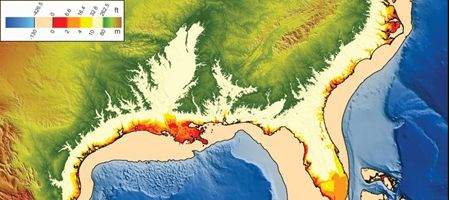Current measurements show that sea levels are rising faster than predicted, with a one-meter rise looking likely by the end of the century.

The last official IPCC report in 2007 projected a global sea level rise of between 0.2 and 0.5 meters by the year 2100. But measurements show it’s going up much faster. The models, say University of Colorado geologist Bill Hay, are ignoring critical feedbacks that speed everything up.
These feedbacks take place in relation to Arctic sea ice, the Greenland ice cap and soil moisture and groundwater mining.
Melting sea ice, which is already in the ocean, doesn’t itself raise sea level. But it does play a part in the overall warming of the Arctic, which leads to ice losses in nearby Greenland and northern Canada. When sea ice melts, more fresh water is released from the Arctic, and replaced by inflows of brinier, warmer water from the south.
“So it’s a big heat pump that brings heat to the Arctic,” says Hay. “That’s not in any of the models.”
Another factor is the gigantic store of ice in Greenland and Antarctica. Last summer, Greenland underwent a record-setting melt. Ice streams, lubricated by water at their base, are speeding up.
“Ten years ago we didn’t know much about water under the Antarctic ice cap,” says Hay. “It’s being squeezed like toothpaste out of a tube.”
Another missing feedback is the groundwater being mined all over the world to mitigate droughts – and which ultimately ends up in the oceans.
“You would expect negative feedbacks to creep in at some point,” says Hay. “But in climate change, every feedback seems to go positive. Under human prodding, the system wants to go into a new climate state.”






